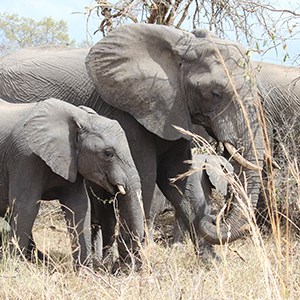Contact
Page editor: David.Stephansson@slu.se

The average body size of grazing animals in a landscape affects the balance of nutrients that are available to plants, researchers including Dr Joris Cromsigt from SLU find. This nutrient balance, particularly the ratios of key nutrients such as nitrogen and phosphorus, determines plant productivity. Feces deposited by herbivores represent an important source of these nutrients, and the researchers show that the nutrient profile of herbivore waste depends on the size of the animal.
Body size of grazing animals
"Factors such as predation risk and food availability determine whether a landscape is visited mainly by larger-bodied or smaller herbivores, while the amount of dung that accumulates stays roughly the same," says first author Dr Elizabeth le Roux of Nelson Mandela University in South Africa (currently University of Oxford). Larger-bodied herbivores, such as rhino and elephant, may dominate areas with high predation risk. Their dung contains relatively more nitrogen and less phosphorus than the deposits of smaller herbivores, such as impala and wildebeest, which may dominate areas perceived as safe. As a result, the researchers revealed that plants that grow in areas visited more often by the largest grazers receive different nutrient supplies from the defecating herbivore community than plants in areas with mainly smaller herbivores.
Consequences of extinction events
According to Joris Cromsigt, these findings suggest that processes that change the relative abundance of large versus small herbivores in ecosystems can alter the nutrients that are available to plants. For plant productivity the best would be when large and smaller grazing animals are in balance in a landscape, he says. This finding offers further insight into the consequences of extinction events. "Extinction events lead to large mammal communities that are increasingly dominated by smaller-bodied herbivores. Our study highlights that this likely affects the ratio of nutrient supply, also called ecological stoichiometry, of ecosystems. This may have broader implications as ecological stoichiometry has been linked to diverse issues, such as carbon sequestration and biodiversity," says Cromsigt.
More diverse herbivore communities
The findings apply to grassy biomes globally, which cover about 40% of the terrestrial land surface, and suggest that sustainable production in these biomes could benefit from grazing by more diverse herbivore communities than is often the case at present.
Fieldwork in savanna grasslands
The researchers conducted the fieldwork in the savanna grasslands of Hluhluwe-iMfolozi Park, South Africa, as part of a collaborative project between Utrecht University, Nelson Mandela University and the Swedish University of Agricultural Sciences.
Joris Cromsigt, Senior Lecturer
Department of Wildlife, Fish and Environmental Studies
Swedish University of Agricultural Sciences
joris.cromsigt@slu.se
https://www.slu.se/en/ew-cv/joris-cromsigt/
Elizabeth le Roux, Laura S. van Veenhuisen, Graham I. H. Kerley & Joris P. G. M. Cromsigt. 2020. Animal body size distribution influences the ratios of nutrients supplied to plants. www.pnas.org/cgi/doi/10.1073/pnas.2003269117
(May be published without charge in articles about this press release, please acknowledge the photographer).
Impalas in Hluhluwe-iMfolozi Park. Photo: Elizabeth le Roux
Elephants in Hluhluwe-iMfolozi Park. Photo: Elizabeth le Roux
Page editor: David.Stephansson@slu.se